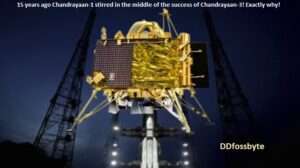In a captivating turn of events, Chandrayaan-1, a groundbreaking mission launched 15 years ago, finds itself in the spotlight once again, this time intertwined with the success story of Chandrayaan-3. But what is the story behind this intriguing connection?

Fifteen years ago, the Indian Space Research Organisation (ISRO) embarked on a historic journey with Chandrayaan-1. This lunar mission was a remarkable feat for India, marking its entry into the elite club of nations with lunar exploration capabilities. Chandrayaan-1 had a significant mission objective: to survey the Moon and provide crucial data about its surface composition and topography.
However, the Chandrayaan-1 mission took an unexpected twist. Initially hailed as a resounding success, it faced an abrupt end in August 2009 when ISRO lost contact with the spacecraft. The mission seemed to have reached an untimely conclusion, leaving many questions unanswered.
Fast forward to the present day, and Chandrayaan-3 has taken center stage. This mission, set to rekindle India’s lunar ambitions, aims to achieve what its predecessor could not. Chandrayaan-3’s primary objective is to make a soft landing on the Moon’s surface, demonstrating India’s prowess in lunar lander technology.

Now, you might be wondering, what links these two missions, separated by a decade and a half? The answer lies in the invaluable experience gained from Chandrayaan-1.
Chandrayaan-1, despite its unexpected end, provided ISRO with a treasure trove of knowledge. It offered crucial insights into lunar exploration, laying the foundation for subsequent missions like Chandrayaan-2 and Chandrayaan-3. The data gathered during its mission revealed vital details about the Moon’s composition and the presence of water molecules on its surface.
Chandrayaan-3, benefiting from the lessons learned from Chandrayaan-1, carries the dreams of a nation eager to conquer new frontiers in space exploration. Its success could be seen as a continuation of the legacy left by Chandrayaan-1, breathing new life into India’s lunar aspirations.

India has made history once again by becoming the fourth country to successfully land a spacecraft on the lunar surface. Notably, this achievement distinguishes India as the first nation to land a spacecraft on the lunar South Pole. The triumph is attributed to the relentless efforts of ISRO scientists who embarked on their third lunar mission, Chandrayaan-3.
However, amidst the euphoria surrounding the success of Chandrayaan-3, Chandrayaan-1, ISRO’s maiden lunar mission launched 15 years ago, has unexpectedly returned to the spotlight, prompting discussions about its significance.
Chandrayaan-1’s mission yielded a remarkable discovery—it was the first mission to detect the presence of water on the Moon. The information it provided was instrumental in uncovering the source of water on our celestial neighbor. Naturally, this revelation added an extra layer of joy and significance to India’s recent lunar success with Chandrayaan-3.

Chandrayaan-1, India’s first lunar mission, was launched in 2008. The mission was a success, and it made several important discoveries, including the presence of water ice on the Moon.
The success of Chandrayaan-3 has renewed interest in Chandrayaan-1. Some experts believe that Chandrayaan-1’s data could be used to help Chandrayaan-3 scientists better understand the Moon.

Chandrayaan-1’s remarkable journey from 15 years ago has left an indelible mark on India’s lunar exploration endeavors. Its unexpected connection to the Chandrayaan-3 mission showcases the resilience of ISRO and the unwavering pursuit of knowledge and discovery in the vast expanse of space.
